小学英语全部语法知识点总结之一
英语中小学语法知识点总结

英语中小学语法知识点总结一、动词时态1. 一般现在时:表示现在的动作或状态。
例如:I go to school every day.2. 一般过去时:表示过去的动作或状态。
例如:She ate an apple yesterday.3. 一般将来时:表示将来的动作或状态。
例如:They will visit Beijing next week.4. 现在进行时:表示现在正在进行的动作。
例如:I am watching TV.5. 过去进行时:表示过去正在进行的动作。
例如:They were playing basketball at 3o'clock yesterday.6. 现在完成时:表示动作已经完成,对现在具有影响。
例如:She has finished her homework.7. 过去完成时:表示过去某个时间点前已经完成的动作。
例如:I had read the book before the test.8. 将来完成时:表示将来某个时间点之前已经完成的动作。
例如:They will have arrivedat the airport by 8 o'clock.二、名词1. 可数名词和不可数名词。
可数名词有单数和复数形式,不可数名词没有复数形式。
例如:book(可数名词)- books(复数), water(不可数名词)。
2. 名词所有格:表示名词所有关系的一种形式。
例如:Tom's book, the girls' school.3. 物主代词:表示所属关系的代词。
例如:my, your, his, her, its, our, their.三、形容词1. 形容词的位置:通常放在名词前面修饰名词。
例如:a tall building, a red car.2. 比较级和最高级:形容词的比较形式。
例如:taller, tallest.3. 不规则比较级和最高级:例如:good - better - best, bad - worse - worst.四、副词1. 副词的种类:用来修饰动词、形容词等词的词。
原创小学英语语法知识点归纳与总结

原创小学英语语法知识点归纳与总结一、名词(Noun)1. 名词的基本用法•名词是指人、事物、地方和抽象概念的名称。
•常见的名词有单数和复数形式,复数形式通常在名词后面加-s或-es。
2. 可数名词与不可数名词•可数名词(Countable Nouns)指可以数的名词,可以用于单数和复数形式。
•不可数名词(Uncountable Nouns)指不能用数量来表示的名词,只有单数形式。
•如:apple(可数)、water(不可数)3. 特殊名词形式•名词所有格(Noun Possessive)表示所属关系,一般在名词后加-apostrophe+s。
•如:Tom’s book(汤姆的书)二、动词(Verb)1. 动词的基本用法•动词是指表示动作、存在或状态的词语。
•动词通常有基本形式、过去式和现在分词形式。
2. 一般现在时•一般现在时(Simple Present Tense)用于表示经常性的动作、习惯性的行为或客观事实。
•一般现在时的构成:主语 + 动词原形•如:She plays soccer every week.(她每周都踢足球。
)3. 一般过去时•一般过去时(Simple Past Tense)用于表示过去某个时间或事情。
•一般过去时的构成:主语 + 动词过去式•如:They watched a movie yesterday.(他们昨天看了一部电影。
)4. 现在进行时•现在进行时(Present Continuous Tense)用于表示现在正在进行的动作。
•现在进行时的构成:主语 + am/is/are + 动词-ing•如:She is playing basketball now.(她正在打篮球。
)5. 一般将来时•一般将来时(Simple Future Tense)用于表示将来会发生的动作或事件。
•一般将来时的构成:主语 + will + 动词原形•如:We will go to the park tomorrow.(我们明天将去公园。
小学英语语法知识总结
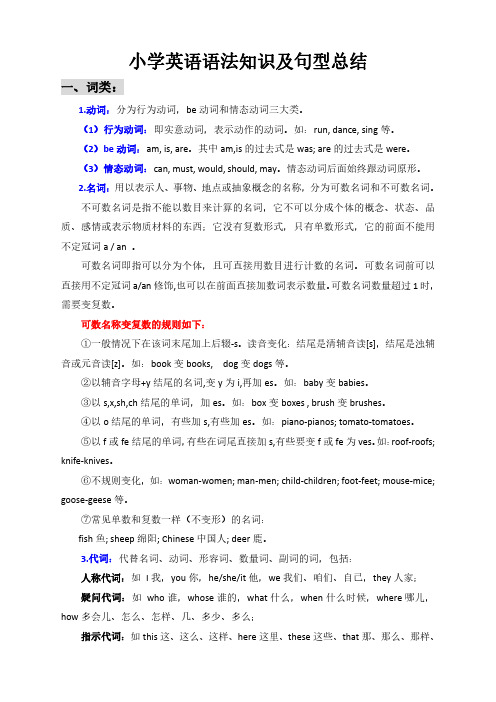
小学英语语法知识及句型总结一、词类:1.动词:分为行为动词,be动词和情态动词三大类。
(1)行为动词:即实意动词,表示动作的动词。
如:run,dance,sing等。
(2)be动词:am,is,are。
其中am,is的过去式是was;are的过去式是were。
(3)情态动词:can,must,would,should,may。
情态动词后面始终跟动词原形。
2.名词:用以表示人、事物、地点或抽象概念的名称,分为可数名词和不可数名词。
不可数名词是指不能以数目来计算的名词,它不可以分成个体的概念、状态、品质、感情或表示物质材料的东西;它没有复数形式,只有单数形式,它的前面不能用不定冠词a/an。
可数名词即指可以分为个体,且可直接用数目进行计数的名词。
可数名词前可以直接用不定冠词a/an修饰,也可以在前面直接加数词表示数量。
可数名词数量超过1时,需要变复数。
可数名称变复数的规则如下:①一般情况下在该词末尾加上后辍-s。
读音变化:结尾是清辅音读[s],结尾是浊辅音或元音读[z]。
如:book变books,dog变dogs等。
②以辅音字母+y结尾的名词,变y为i,再加es。
如:baby变babies。
③以s,x,sh,ch结尾的单词,加es。
如:box变boxes,brush变brushes。
④以o结尾的单词,有些加s,有些加es。
如:piano-pianos;tomato-tomatoes。
⑤以f或fe结尾的单词,有些在词尾直接加s,有些要变f或fe为ves。
如:roof-roofs; knife-knives。
⑥不规则变化,如:woman-women;man-men;child-children;foot-feet;mouse-mice; goose-geese等。
⑦常见单数和复数一样(不变形)的名词:fish鱼;sheep绵阳;Chinese中国人;deer鹿。
3.代词:代替名词、动词、形容词、数量词、副词的词,包括:人称代词:如I我,you你,he/she/it他,we我们、咱们、自己,they人家;疑问代词:如who谁,whose谁的,what什么,when什么时候,where哪儿,how多会儿、怎么、怎样、几、多少、多么;指示代词:如this这、这么、这样、here这里、these这些、that那、那么、那样、there那里、those那些”。
小学英语必考知识点总结_小学英语总结

小学英语必考知识点总结_小学英语总结一、基本语法知识点1. 动词be的变化和用法2. 动词have的变化和用法3. 现在进行时的构成和用法4. 一般现在时的构成和用法5. 一般过去时的构成和用法6. 形容词的用法和比较级、最高级的构成7. 名词的单复数形式8. 介词的基本用法9. 冠词的基本用法10. 句子的基本结构(肯定句、否定句、疑问句)二、常见单词及词组1. 数字1-100的表达2. 时间表达:days of the week、months of the year3. 表示家庭成员的词汇4. 表示动物、水果、蔬菜、食物的词汇5. 表示颜色、形状、大小的词汇6. 常见国家、城市的名称7. 常见的学科名称和动词8. 表示日常活动的词汇三、日常交际用语1. 问候语2. 表示喜欢或不喜欢的词汇3. 表示身体部位的词汇4. 表示情感的词汇5. 表示方向的词汇四、常见句型1. What’s this/that? It’s a/an…2. Is this/that a …? Yes, it is. / No, it isn’t.3. What colour is it? It’s…4. How many… are there? There are…5. What’s your/his/her name? My/His/Her name is…6. How old are you? I am … years old.7. Do you like…? Yes, I do. / No, I don’t.8. Where are you from? I am from…五、日常活动1. 描述日常活动的词汇及句子2. 描述日常活动的频率:always、usually、often、sometimes、never3. 表达日常活动所需的动词短语六、常见情景对话1. 自我介绍2. 询问年龄、姓名3. 询问喜欢的食物、颜色等4. 询问材料、颜色5. 询问位置、方向七、常见教学用语1. 教室用语和课堂指令2. 学习用具的名称3. 学习场所和物品的名称八、其他1. 常用生活用语和短语2. 主题相关的歌曲、儿歌和故事3. 形式多样的综合练习题,包括听力、口语、阅读、写作。
小学英语语法知识点归纳

千里之行,始于足下。
小学英语语法知识点归纳小学英语语法知识点归纳一、词性(Parts of Speech)1. 名词(Noun):表示人、动物、事物、地方等的名称。
2. 代词(Pronoun):代替名词的词,如he、she、it等。
3. 形容词(Adjective):描述名词的特征和属性。
4. 副词(Adverb):修饰动词、形容词和副词,表示程度、时间、地点等关系。
5. 动词(Verb):表示动作或状态。
6. 介词(Preposition):表示事物的方位、关系等,如on、in、under 等。
7. 连词(Conjunction):用于连接词与词,句子与句子之间的关系,如and、but、or等。
8. 冠词(Article):用于限定名词的词,分为定冠词和不定冠词,如a、an、the等。
二、句子结构(Sentence Structure)1. 主语谓语结构(Subject and Predicate Structure):由主语和谓语构成的基本句子结构。
2. 宾语(Object):句子中接受动作的人或事物。
3. 宾语补语(Object Complement):用来补充说明宾语的成分。
4. 定语(Attribute):用来修饰名词或代词的词或短语。
5. 状语(Adverbial):用来提供关于动作发生方式、时间、地点等信息的成分。
三、基本句型(Basic Sentence Patterns)第1页/共3页锲而不舍,金石可镂。
1. 主谓句型(Subject and Predicate Sentence Pattern):由主语和谓语构成的句子。
- 例如:She sings.(她唱歌。
)2. 主谓宾句型(Subject, Predicate and Object Sentence Pattern):在主谓句型基础上加上宾语。
- 例如:She sings a song.(她唱一首歌。
)3. 主谓宾宾补句型(Subject, Predicate, Object and Object Complement Sentence Pattern):在主谓宾句型基础上加上宾语补语。
小学所有英语语法知识点归纳总结

小学所有英语语法知识点归纳总结英语语法是学习英语的基础,掌握好语法知识对于小学生来说非常重要。
下面对小学所有英语语法知识点进行归纳总结,帮助同学们更好地学习和理解。
一、名词(Noun)名词是指人、事物、地点等具体或抽象的实体。
名词的种类分为可数名词和不可数名词。
1. 可数名词(Countable Noun)可数名词是指可以用数字来计数的名词。
可数名词的单数形式和复数形式存在区别,复数形式通常在词尾添加-s或-es。
例:单数:book(书)复数:books(书籍)单数:dog(狗)复数:dogs(狗)2. 不可数名词(Uncountable Noun)不可数名词是指无法进行数学计数的名词,它们表示一种整体或抽象的概念。
不可数名词没有复数形式。
例:milk(牛奶) water(水) music(音乐)二、代词(Pronoun)代词是用来替代名词或名词短语的词语。
根据其使用方式和指代对象,代词分为以下几种类型:1. 人称代词(Personal Pronoun)人称代词用来代替人或事物的特定人称。
主格:I(我) you(你) he(他) she(她) it(它) we(我们)they(他们)宾格:me(我) you(你) him(他) her(她) it(它) us(我们)them(他们)形容词性物主代词:my(我的) your(你的) his(他的) her(她的) its(它的) our(我们的) their(他们的)名词性物主代词:mine(我的) yours(你的) his(他的) hers(她的) its(它的) ours(我们的) theirs(他们的)2. 指示代词(Demonstrative Pronoun)指示代词用来指示特定的人或事物。
this(这) that(那) these(这些) those(那些)3. 不定代词(Indefinite Pronoun)不定代词用来代替不确定或未具体指定的人或事物。
小学英语重点语法汇总

(表⽰作为⽔) →Miss"祈"加⼊"-s"或"-es第三,我的变化--否定句、⼀般疑问句、特殊疑问句:1. be动词的变化。
否定句:主语+ be + not +其它。
如:He is not a worker.他不是⼯⼈。
⼀般疑问句:Be +主语+其它。
如:-Are you a student?-Yes. I am. / No, I'm not.特殊疑问句:疑问词+⼀般疑问句。
如:Where is my bike?2. ⾏为动词的变化。
否定句:主语+ don't( doesn't ) +动词原形(+其它)。
如:I don't like bread.当主语为第三⼈称单数时,要⽤doesn't构成否定句。
如:He doesn't often play.⼀般疑问句:Do( Does ) +主语+动词原形+其它。
如:- Do you often play football?- Yes, I do. / No, I don't.当主语为第三⼈称单数时,要⽤does构成⼀般疑问句。
如:- Does she go to work by bike?- Yes, she does. / No, she doesn't.特殊疑问句:疑问词+⼀般疑问句。
如:How does your father go to work?⼩朋友们,下次见到我时,千万不要忘记我是"⼀般现在时"啊!See you next time!揭开“第三⼈称单数”的秘密善问⼤王: Good afternoon , Mr Huang. 学完⼀般现在时之后,我对哪些主语属于第三⼈称单数还不太清楚,请您给我讲⼀讲好吗?Mr Huang: 你可真是⼀个勤学好问的好学⽣!哪些主语是第三⼈称单数这可是个⼩秘⼀、第三⼈称代词 he, she, it 作主语时。
小学英语语法知识点归纳
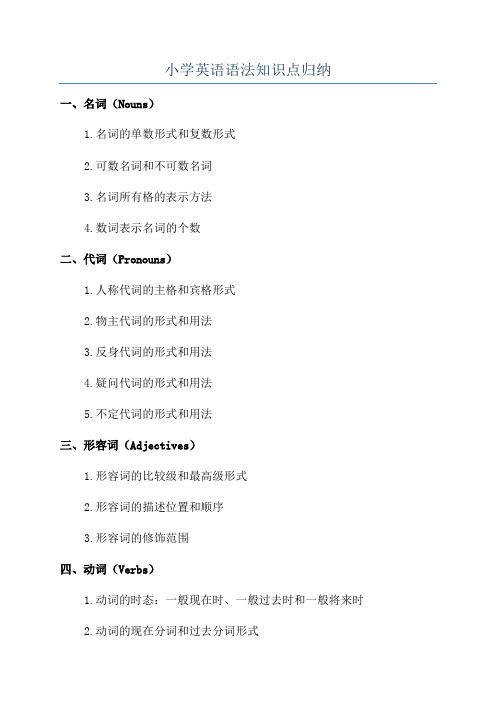
小学英语语法知识点归纳一、名词(Nouns)1.名词的单数形式和复数形式2.可数名词和不可数名词3.名词所有格的表示方法4.数词表示名词的个数二、代词(Pronouns)1.人称代词的主格和宾格形式2.物主代词的形式和用法3.反身代词的形式和用法4.疑问代词的形式和用法5.不定代词的形式和用法三、形容词(Adjectives)1.形容词的比较级和最高级形式2.形容词的描述位置和顺序3.形容词的修饰范围四、动词(Verbs)1.动词的时态:一般现在时、一般过去时和一般将来时2.动词的现在分词和过去分词形式3.一般现在时的特殊疑问句和否定句4.动词的被动语态5.动词的情态动词6.动词的非谓语形式:动名词和不定式五、副词(Adverbs)1.副词修饰动词、形容词和副词的用法2.频度副词的表示方法3.比较副词的形式和用法4.疑问副词的形式和用法六、介词(Prepositions)1. 常见介词的用法:in、on、under、behind等2.介词短语的表示方式七、连词(Conjunctions)1. 表示并列关系的连词:and、but、or等2. 表示选择关系的连词:either...or、neither...nor等3. 表示因果关系的连词:because、so等4. 表示转折关系的连词:however、although等八、数词(Numerals)1.基数词和序数词的用法2.几分之几的表达方式九、冠词(Articles)1. 定冠词(the)和不定冠词(a/an)的用法十、句子(Sentences)1.句子的主谓结构和宾语结构2.简单句、并列句、复合句的构成3.特殊疑问句的构成以上是小学英语语法的一些基本知识点归纳,但在学习英语语法的过程中还需要通过大量的实践和练习来掌握和运用这些知识点,并逐渐提高语法的准确性和流利度。
小学六年级英语语法知识点汇总1
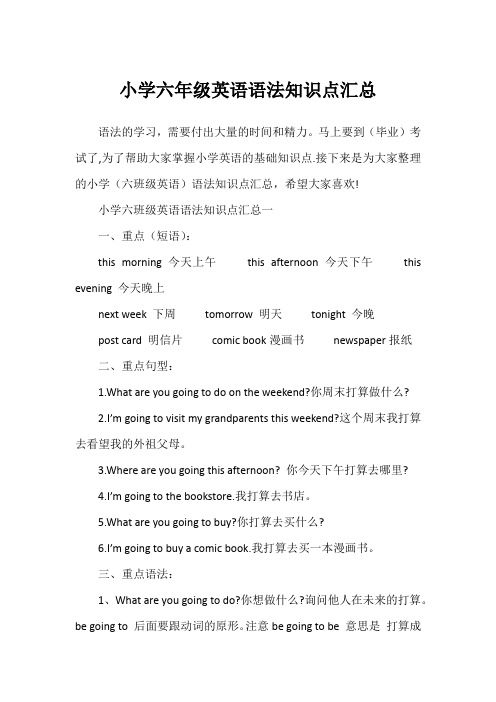
小学六年级英语语法知识点汇总语法的学习,需要付出大量的时间和精力。
马上要到(毕业)考试了,为了帮助大家掌握小学英语的基础知识点.接下来是为大家整理的小学(六班级英语)语法知识点汇总,希望大家喜欢!小学六班级英语语法知识点汇总一一、重点(短语):this morning 今天上午this afternoon 今天下午this evening 今天晚上next week 下周tomorrow 明天tonight 今晚post card 明信片comic book漫画书newspaper报纸二、重点句型:1.What are you going to do on the weekend?你周末打算做什么?2.I’m going to visit my grandparents this weekend?这个周末我打算去看望我的外祖父母。
3.Where are you going this afternoon? 你今天下午打算去哪里?4.I’m going to the bookstore.我打算去书店。
5.What are you going to buy?你打算去买什么?6.I’m going to buy a comic book.我打算去买一本漫画书。
三、重点语法:1、What are you going to do?你想做什么?询问他人在未来的打算。
be going to 后面要跟动词的原形。
注意be going to be 意思是打算成为什么,干什么职业。
注意一下(句子)的区别,找出正确回答。
What are you going to do this afternoon?What are you going to buy?What are you going to be?When? are you going?Where are you going?How are you going?Who are you going with?2、this evening 和tonight的区别:this evening指的是今天晚上睡觉以前的时间,一般指晚上十二点以前。
英语中小学语法知识点总结

英语中小学语法知识点总结一、基础语法知识1. 词类划分:名词(Noun)、动词(Verb)、形容词(Adjective)、副词(Adverb)、代词(Pronoun)、介词(Preposition)、连词(Conjunction)、冠词(Article)、感叹词(Interjection)。
2. 句子结构:主语(Subject)、谓语(Predicate)、宾语(Object)、表语(Predicate Complement)、定语(Adjective)、状语(Adverbial)、补语(Complement)等。
3. 时态和语态:英语动词的时态包括一般现在时、一般过去时、一般将来时、现在进行时、过去进行时、过去将来时等。
英语动词的语态包括主动语态和被动语态。
4. 单复数形式:名词的复数形式一般在词尾加-s或-es,有些名词有不规则的复数形式。
5. 形容词和副词的形式:形容词和副词的比较级和最高级形式,一般是在词尾加-er(比较级)和-est(最高级)。
二、句子成分1. 主语和谓语:主谓一致性,即主语和谓语在人称和数上保持一致。
2. 宾语和宾语补足语:宾语是动词的直接受事者,宾语补足语用于补充或说明宾语。
3. 主语补足语和表语:主语补足语和表语用来对主语进行补充、说明或描述。
4. 定语:定语用来修饰名词或代词,常用的定语包括形容词、限定词、副词等。
5. 状语:状语用来修饰动词、形容词或副词,表示时间、地点、方式、原因等。
三、从句和复合句1. 名词性从句:名词性从句可以作为主语、宾语、表语或同位语,常见的名词性从句包括主语从句、宾语从句、表语从句和同位语从句。
2. 定语从句:定语从句用来修饰名词或代词,常用的引导词有关系代词和关系副词。
3. 状语从句:状语从句用来修饰动词、形容词或副词,表示时间、原因、条件、结果等。
4. 同位语从句:同位语从句用来对前面的名词或代词进行解释或说明。
四、其他语法知识点1. 倒装句:倒装句的主谓语调换位置,常见的有完全倒装和部分倒装。
小学英语语法总复习知识点归纳

小学英语语法总复习知识点归纳1.词汇与词组- 动词be的变形及使用(am, is, are)- 人称代词(I, you, he, she, it, we, they)-一般现在时的动词变形及使用- 常见形容词(happy, sad, big, small, etc.)- 常见副词(quickly, slowly, well, etc.)- 常见连词(and, but, or, so, because, etc.)- 常见介词(in, on, under, behind, etc.)-数字的表达方式及使用2.句子结构-主语和谓语的搭配-主谓一致- 物主代词(my, your, his, her, its, our, their)3.一般现在时-用于表示经常发生的动作或状态-用于表达客观事实-肯定句、否定句、疑问句的构成及变化4.一般过去时-表示过去发生的动作或状态-动词的过去式的构成规则-肯定句、否定句、疑问句的构成及变化5.现在进行时-表示现在正在进行的动作-现在进行时的构成规则-肯定句、否定句、疑问句的构成及变化6.简单将来时-表示将来发生的动作或状态-一般将来时的构成规则-肯定句、否定句、疑问句的构成及变化7.名词-可数名词和不可数名词的区分-可数名词的单数和复数形式-不可数名词的用法及特点8.代词-主格和宾格的使用-物主代词的用法及特点-反身代词的用法及特点9.形容词-形容词的用法及特点-形容词的比较级和最高级的构成规则-形容词的比较级和最高级的用法10.副词-副词的用法及特点-副词在句子中的位置-副词修饰动词、形容词和副词的用法11.冠词- 不定冠词a和an的使用- 定冠词the的使用-零冠词的使用12.介词-介词的用法及特点-介词短语的使用-介词与名词、代词、动词的搭配13.连词- 并列连词的使用(and, but, or)- 选择连词的使用(either...or, neither...nor)- 原因连词的使用(because, so, therefore)14.感叹句-感叹句的构成规则-感叹句中感叹词的使用-常见感叹句的用法15.注意事项-动词的时态和语态的正确使用-不同词性的词在句子中的位置-注意名词复数形式的规则。
总结小学英语语法知识点
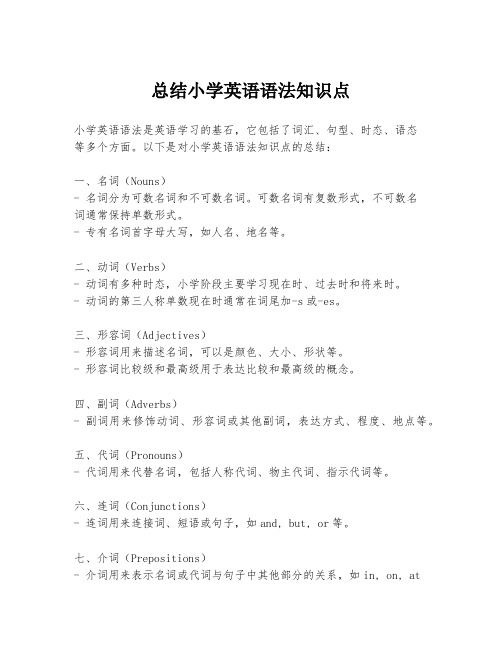
总结小学英语语法知识点小学英语语法是英语学习的基石,它包括了词汇、句型、时态、语态等多个方面。
以下是对小学英语语法知识点的总结:一、名词(Nouns)- 名词分为可数名词和不可数名词。
可数名词有复数形式,不可数名词通常保持单数形式。
- 专有名词首字母大写,如人名、地名等。
二、动词(Verbs)- 动词有多种时态,小学阶段主要学习现在时、过去时和将来时。
- 动词的第三人称单数现在时通常在词尾加-s或-es。
三、形容词(Adjectives)- 形容词用来描述名词,可以是颜色、大小、形状等。
- 形容词比较级和最高级用于表达比较和最高级的概念。
四、副词(Adverbs)- 副词用来修饰动词、形容词或其他副词,表达方式、程度、地点等。
五、代词(Pronouns)- 代词用来代替名词,包括人称代词、物主代词、指示代词等。
六、连词(Conjunctions)- 连词用来连接词、短语或句子,如and, but, or等。
七、介词(Prepositions)- 介词用来表示名词或代词与句子中其他部分的关系,如in, on, at等。
八、数词(Numerals)- 数词包括基数词和序数词,分别用来表示数量和顺序。
九、时态(Tenses)- 现在时表示现在发生的动作或状态。
- 过去时表示过去发生的动作或状态。
- 将来时表示将来发生的动作或状态。
十、语态(Voices)- 主动语态和被动语态是英语中两种基本的语态形式。
十一、句子结构(Sentence Structure)- 简单句、并列句和复合句是英语句子的基本结构。
十二、疑问句和否定句- 疑问句用来提问,否定句用来表达否定意义。
十三、直接引语和间接引语- 直接引语是引用别人的话,间接引语是转述别人的话。
十四、条件句- 条件句用来表达在特定条件下可能发生的事情。
通过以上知识点的学习和掌握,小学生可以构建起坚实的英语语法基础,为进一步的英语学习打下良好的基础。
小学英语知识点(语法,句型,词汇)
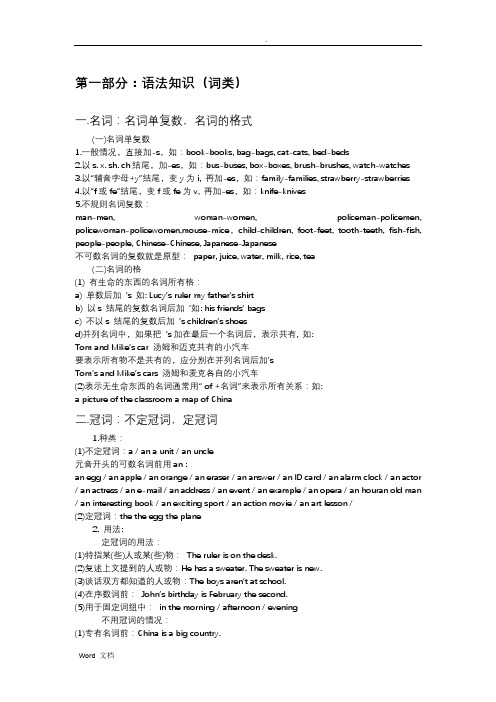
第一部分:语法知识(词类)一.名词:名词单复数,名词的格式(一)名词单复数1.一般情况,直接加-s,如:book-books, bag-bags, cat-cats, bed-beds2.以s. x. sh. ch结尾,加-es,如:bus-buses, box-boxes, brush-brushes, watch-watches3.以“辅音字母+y”结尾,变y为i, 再加-es,如:family-families, strawberry-strawberries4.以“f或fe”结尾,变f或fe为v, 再加-es,如:knife-knives5.不规则名词复数:man-men, woman-women, policeman-policemen, policewoman-policewomen,mouse-mice,child-children, foot-feet, tooth-teeth, fish-fish, people-people, Chinese-Chinese, Japanese-Japanese不可数名词的复数就是原型:paper, juice, water, milk, rice, tea(二)名词的格(1) 有生命的东西的名词所有格:a) 单数后加’s 如: Lucy’s ruler my father’s shirtb) 以s 结尾的复数名词后加’如: his friends’ bagsc) 不以s 结尾的复数后加’s children’s shoesd)并列名词中,如果把’s加在最后一个名词后,表示共有, 如:Tom and Mike’s car 汤姆和迈克共有的小汽车要表示所有物不是共有的,应分别在并列名词后加’sTom’s and Mike’s cars 汤姆和麦克各自的小汽车(2)表示无生命东西的名词通常用“ of +名词”来表示所有关系:如:a picture of the classroom a map of China二.冠词:不定冠词,定冠词1.种类:(1)不定冠词:a / an a unit / an uncle元音开头的可数名词前用an :an egg / an apple / an orange / an eraser / an answer / an ID card / an alarm clock / an actor / an actress / an e-mail / an address / an event / an example / an opera / an houran old man / an interesting book / an exciting sport / an action movie / an art lesson /(2)定冠词:the the egg the plane2. 用法:定冠词的用法:(1)特指某(些)人或某(些)物:The ruler is on the desk.(2)复述上文提到的人或物:He has a sweater. The sweater is new.(3)谈话双方都知道的人或物:The boys aren’t at school.(4)在序数词前:John’s birthday is February the second.(5)用于固定词组中:in the morning / afternoon / evening不用冠词的情况:(1)专有名词前:China is a big country.(2)名词前有定语:this , that , my , your , some, any , no 等:This is my baseball.(3)复数名词表示一类人和事:Monkeys can’t swim. They are teachers.(4)在节日,日期,月份,季节前:Today is Christmas Day. It’s Sunday.(5)一日三餐前:We have breakfast at 6:30.(6)球类棋类运动前:They often play football after class. He plays chess at home(7)学科名称前:My favorite subject is music.(8)在称呼或头衔的名词前:This is Mr Li.(9)固定词组中:at noon at night by bus三、代词、形容词、副词1.代词:人称代词(主格,宾格),物主代词第一人称单数I(我)me my(我的)复数we(我们)us our(我们的)第二人称单数you(你)you your(你的)复数you(你们)you your(你们的)第三人称单数he(他)him his(他的)she(她)her her(她的)it(它)it its(它的)复数they(他们/她们/它们)them their(他们的/她们的/它们的)2.形容词,副词:比较级,最高级(一)形容词的比较级1、形容词比较级在句子中的运用:两个事物或人的比较用比较级,比较级后面一般带有单词than。
完整版新版人教版小学英语各级知识点总结(一)

完整版新版人教版小学英语各级知识点总结(一)随着小学英语教育的发展,各种不同版本的教材和教育资源也不断涌现。
其中,新版人教版小学英语完整版教材是国内教育领域广泛使用的教材之一。
本文将为大家总结完整版新版人教版小学英语各级的知识点。
一、小学英语一年级(上册)1.日常用语:每日问候语、表达喜欢或不喜欢的事物等。
2.基本单词:单词发音、拼写和意义。
3.数字:0-100的数字以及表示时间的数字。
4.动词:表示基本动作的动词和一些常见的动词短语。
5.形容词:表示颜色、形状和大小的形容词。
二、小学英语一年级(下册)1.日常用语:家庭成员、服饰、食品等方面的表达。
2.基本单词:动物、学校和身体部位的单词。
3.数字:101-1000的数字以及几点钟的时间表达法。
4.介词:表示方位、时间和状态的介词。
5.连词:连接两个或多个词语、句子或文本的连词。
三、小学英语二年级(上册)1.单词:食品、水果、蔬菜、物品、家庭和交通工具的单词。
2.句型:简单的英语句型、简单的陈述句和疑问句。
3.时态:现在进行时、过去式以及下雨、下雪等特殊的词汇运用。
4.名词:单数和复数形式的名词、可数和不可数名词。
5.介词:和空间连用的介词和介词短语。
四、小学英语二年级(下册)1.单词:衣服、季节、自然景观以及形容词和定冠词。
2.句型:用英语进行日常生活对话的能力。
3.动词时态:现在进行时和一般将来时。
4.名词:所有格以及指示代词。
5.简单的生活场景、听力和口语实践。
五、小学英语三年级(上册)1.单词:天气、家居、食物等方面的词汇。
2.动词:一些常见的动词短语以及简单的英语动作词汇。
3.句型:英语语法中的一些基本句型、语序和从句的相关知识。
4.时态:现在时、过去时和将来时等时态的语言运用。
5.英语听力和口语实践。
六、小学英语三年级(下册)1.单词:职业、生活方式、体育和娱乐方面的词汇。
2.动词:表达完成和未来事件的动词短语。
3.句型:陈述句和疑问句、情态动词和反意疑问句。
小学生英语语法知识点总结归纳

小学生英语语法知识点总结归纳一、名词(Noun)名词是指表示人、事物、地点、抽象概念等的词语。
一般分为以下几类:1.1 普通名词(Common Nouns):泛指任何一类人、事物或抽象概念,如book(书)、teacher(老师)等。
1.2 专有名词(Proper Nouns):指具体的人、地点或机构的名称,如Tom(汤姆)、London(伦敦)。
1.3 集体名词(Collective Nouns):用来表示一群人或事物的名词,如team(队伍)、family(家庭)。
1.4 可数名词(Countable Nouns):可用单复数形式表示数量的名词,如apple(苹果)、table(桌子)。
1.5 不可数名词(Uncountable Nouns):不能用单复数形式表示数量的名词,如water(水)、advice(建议)。
二、代词(Pronoun)代词是用来代替名词的词语,可以减少重复,方便表达。
常见的代词有:2.1 人称代词(Personal Pronouns):用来代替人的称呼,如I (我)、he(他)。
2.2 物主代词(Possessive Pronouns):表示所属关系的代词,如mine(我的)、yours(你的)。
2.3 反身代词(Reflexive Pronouns):表示动作反身的代词,如myself(我自己)、yourself(你自己)。
2.4 指示代词(Demonstrative Pronouns):用来指示人或物的代词,如this(这个)、that(那个)。
2.5 疑问代词(Interrogative Pronouns):用来提问的代词,如who (谁)、what(什么)。
三、动词(Verb)动词是表示动作、状态或存在的词语。
常见的动词形式有:3.1 及物动词(Transitive Verbs):需要有宾语才能完整表达意思的动词,如eat(吃)、write(写)。
3.2 不及物动词(Intransitive Verbs):不需要宾语就能完整表达意思的动词,如run(跑)、sleep(睡觉)。
小学英语语法知识要点总结
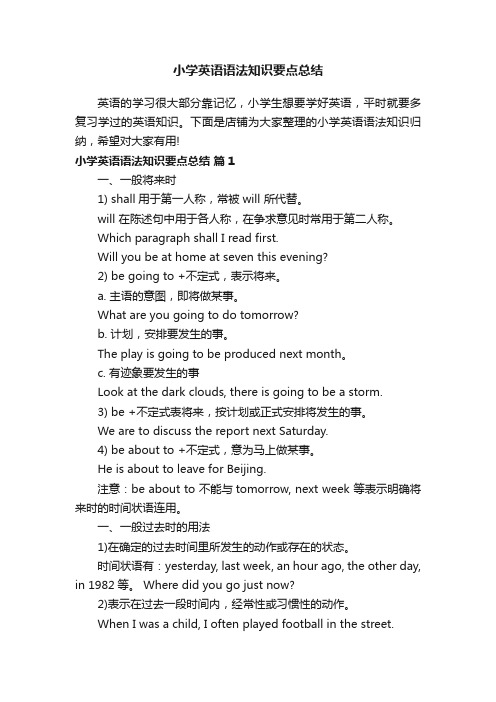
小学英语语法知识要点总结英语的学习很大部分靠记忆,小学生想要学好英语,平时就要多复习学过的英语知识。
下面是店铺为大家整理的小学英语语法知识归纳,希望对大家有用!小学英语语法知识要点总结篇1一、一般将来时1) shall用于第一人称,常被will 所代替。
will 在陈述句中用于各人称,在争求意见时常用于第二人称。
Which paragraph shall I read first.Will you be at home at seven this evening?2) be going to +不定式,表示将来。
a. 主语的意图,即将做某事。
What are you going to do tomorrow?b. 计划,安排要发生的事。
The play is going to be produced next month。
c. 有迹象要发生的事Look at the dark clouds, there is going to be a storm.3) be +不定式表将来,按计划或正式安排将发生的事。
We are to discuss the report next Saturday.4) be about to +不定式,意为马上做某事。
He is about to leave for Beijing.注意:be about to 不能与tomorrow, next week 等表示明确将来时的时间状语连用。
一、一般过去时的用法1)在确定的过去时间里所发生的动作或存在的状态。
时间状语有:yesterday, last week, an hour ago, the other day, in 1982等。
Where did you go just now?2)表示在过去一段时间内,经常性或习惯性的动作。
When I was a child, I often played football in the street.Whenever the Browns went during their visit, they were givena warm welcome.3)句型:It is time for sb. to do sth "到时间了" "该了"It is time sb. did sth. "时间已迟了" "早该了"It is time for you to go to bed. 你该睡觉了。
最全小学英语语法总结[1]
![最全小学英语语法总结[1]](https://img.taocdn.com/s3/m/cbfa5e482b160b4e767fcfae.png)
最全的小学英语语法总结1.人称代词主格:I we you she he it they宾格:me us you her him it them形容词性物主代词:my our your her his its their名词性物主代词:mine ours yours hers his its theirs2.形容词和副词的比较级(1) 一般在形容词或副词后+erolder taller longer stronger, etc(2) 多音节词前+moremore interesting, etc.(3) 双写最后一个字母,再+erbigger fatter, etc.(4) 把y变i,再+erheavier, earlier(5) 不规则变化:well-better, much/many-more, etc.3.可数词的复数形式Most nouns + s a book –booksNouns ending in a consonant +y - y+ ies a story—storiesNouns ending in s, sh, ch or x + es a glass—glasses a watch-watches Nouns ending in o +s or +es a piano—pianos a mango—mangoesNouns ending in f or fe - f or fe +ves a knife –knives a shelf-shelves4.不可数名词(单复数形式不变)bread, rice, water ,juice etc.5. 缩略形式I’m = I am you’re = you are she’s = she is he’s = he isit’s = it is who’s =who is can’t =can not isn’t=is not etc6. a/ana book, a peachan egg an hour7. Preposition:on, in ,in front of, between, next to, near, beside, at, behind.表示时间:at six o’clock, at Christmas, at breakfaston Monday on 15th July On National Dayin the evening in December in winter8. 基数词和序数词one – first two-second twenty-twentieth9. Some /anyI have some toys in my bedroom.Do you have any brothers or sisters?10. be 动词(1) Basic form: am/are/is(2) 肯定和否定句I am(not) from London.My eyes are(not) small.My hair is(not) long.(3)一般疑问句:Am I a Chniese? Yes, you are. No, you aren’t. Are they American? Yes, they are. No, they aren’t.Is the cat fat? Yes, it is. No, it isn’t.11. there be 结构肯定句:There is a …There are …一般疑问句:Is there …? Yes, there is./ No, there isn’t.Are there…? Yes, there are. /No, there aren’t.否定句:There isn’t …. There aren’t….12. 祈使句Sit down pleaseDon’t sit down, please.13. 现在进行时.通常用―now‖.形式:be + verb +ingeg: I am(not) doing my homework.You/We/They are(not) reading.He/She/It is(not) eating.动词—ing 的形式Most verbs +ing walk—walkingVerbs ending in e -e + ing come—comingShort verbs ending in a vowel + a consonant run –running swim—swimming14 一般现在时。
- 1、下载文档前请自行甄别文档内容的完整性,平台不提供额外的编辑、内容补充、找答案等附加服务。
- 2、"仅部分预览"的文档,不可在线预览部分如存在完整性等问题,可反馈申请退款(可完整预览的文档不适用该条件!)。
- 3、如文档侵犯您的权益,请联系客服反馈,我们会尽快为您处理(人工客服工作时间:9:00-18:30)。
小学英语全部语法知识点总结之一:名词、冠词、数词、代词一、名词名词可以分为专有名词和普通名词,专有名词是某个(些)人,地方,机构等专有的名称,如Beijing,China 等。
普通名词是一类人或东西或是一个抽象概念的名词,如:book,football等。
普通名词又可分为下面四类:1)个体名词(Individual Nouns):表示某类人或东西中的个体,如:gun。
2)集体名词(Collective Nouns):表示若干个个体组成的集合体,如:family。
3)物质名词(Material Nouns):表示无法分为个体的实物,如:air。
4)抽象名词(Abstract Nouns):表示动作、状态、品质、感情等抽象概念,如:work。
★其它名词复数的规则变化1) 以y结尾的专有名词,或元音字母+y 结尾的名词变复数时,直接加s变复数:如:two Marys the Henrysmonkey---monkeys holiday---holidays比较:层楼:storey ---storeys story---stories2) 以o 结尾的名词,变复数时:a. 加s,如: photo---photos piano---pianosradio---radios zoo---zoos;b. 加es,如:potato--potatoes tomato--tomatoesc. 均可,如:zero---zeros / zeroes3) 以f或fe 结尾的名词变复数时:a. 加s,如: belief---beliefs roof---roofssafe---safes gulf---gulfs;b. 去f,fe 加ves,如:half---halvesknife---knives leaf---leaves wolf---wolveswife---wives life---lives thief---thieves;c. 均可,如:handkerchief:handkerchiefs / handkerchieves★名词复数的不规则变化1)child---children foot---feet tooth---teethmouse---mice man---men woman---women注意:与 man 和 woman构成的合成词,其复数形式也是 -men 和-women。
如: an Englishman,two Englishmen. 但German不是合成词,故复数形式为Germans;Bowman是姓,其复数是the Bowmans。
2)单复同形如:deer,sheep,fish,Chinese,Japaneseli,jin,yuan,two li,three mu,four jin但除人民币元、角、分外,美元、英镑、法郎等都有复数形式。
如:a dollar, two dollars; a meter, two meters3)集体名词,以单数形式出现,但实为复数。
如: people police cattle 等本身就是复数,不能说 a people,a police,a cattle,但可以说a person,a policeman,a head of cattle,the English,the British,the French,the Chinese,the Japanese,the Swiss 等名词,表示国民总称时,作复数用。
如: The Chinese are industries and brave. 中国人民是勤劳勇敢的。
4)以s结尾,仍为单数的名词,如:a. maths,politics,physics等学科名词,为不可数名词,是单数。
b. news 是不可数名词。
c. the United States,the United Nations 应视为单数。
The United Nations was organized in 1945. 联合国是1945年组建起来的。
d. 以复数形式出现的书名,剧名,报纸,杂志名,也可视为单数。
"The Arabian Nights" is a very interesting story-book.<<一千零一夜>>是一本非常有趣的故事书。
5) 表示由两部分构成的东西,如:glasses (眼镜) trousers, clothes若表达具体数目,要借助数量词 pair(对,双); suit(套); a pair of glasses; two pairs of trousers6)另外还有一些名词,其复数形式有时可表示特别意思,如:goods货物,waters水域,fishes(各种)鱼二、冠词和数词冠词是虚词,本身不能单独使用,也没有词义,它用在名词的前面,帮助指明名词的含义。
英语中的冠词有三种,一种是定冠词,另一种是不定冠词,还有一种是零冠词。
不定冠词a (an)与数词one 同源,是"一个"的意思。
a用于辅音音素前,一般读作[e],而an则用于元音音素前,一般读做[en]。
1) 表示"一个",意为one;指某人或某物,意为a certain。
A Mr. Ling is waiting for you.2) 代表一类人或物。
A knife is a tool for cutting with.Mr. Smith is an engineer.3) 词组或成语。
a little / a few / a lot / a type of / a pile / a great many / many a / as a rule / in a hurry / in a minute / in a word / in a short while / after a while / have a cold / have a try / keep an eye on / all of a sudden★冠词的用法冠词是虚词,放在名词之前,用来说明名词指的人或事物。
冠词有两种。
A(an)叫不定冠词,the叫定冠词。
A用在辅音之前,an用在元音之前。
1. 不定冠词的用法(1) a和an均用在单数名词之前,表示某一类人或事物。
例如:John is a student.Mary is an English teacher.(2) 指某一类人或事物中的任何一个。
例如:A steel worker makes steel.Pass me an apple, please.(3) 指某人或某物,但不具体说明何人或和物。
例如:A student wants to see you.A girl is waiting for you outside.(4) 表示“每一”的意思,相当于every。
例如:Take the medicine three times a day.They go to see their parents once a week.★定冠词用法(1) 特指某(些)人或某(些)事物。
例如:The book on the desk is an English dictionary.Beijing is the capital of China.(2) 指说话人和听话人都熟悉的人或事物。
例如:Open the door, please.Jack is in the library.(3) 上文提到过的人或事物。
例如:Yesterday John’s father bought him a new bike. The bike cost him 200 yuan.(4) 表示世界上独一无二的事物。
例如:The sun rises in the east and sets in the west.(5) 用在序数词和形容词最高级之前。
例如:Shanghai is the biggest city in China.January is the first month of the year.(6) 用在某些形容词之前,表示某一类人或事物。
例如:The nurse is kind to the sick.We should take good care of the old.(7) 用在某些专有名词之前和某些习惯用语中。
例如:the Great Wall, the Summer palace, in the morning, in the open air等。
(8) 用在姓氏复数之前,表示“某某一家人”,“某某夫妇”。
例如:the Browns, the whites等。
★不用冠词的情况(1) 某些专有名词,抽象名词和物质名词前一般不用冠词。
例如:China, Canada, Japanese, glass, water, love等。
(2) 名词前已有作定语用的this, that, my, your, whose, some, any, no, each, every等代词时,不用冠词。
例如:That is my cap.I have some questions.Go down this street.(3) 复数名词表示一类人或事物时,不用冠词。
They are workers.We are students.(4) 称呼语前不用冠词,表示头衔和职务的名词前也不加冠词。
例如:I don’t feel well today, Mother.Bush was made president of the U.S.(5) 三餐饭的名称前,球类活动,学科和节目名词前,常不用冠词。
例如:I have lunch at home.He often plays football after class.We have English and maths every day.(6) 在某些固定词组里,名词之前常不用冠词。
例如:By air, at night, at home, go to bed, go to school, on foot, from morning till night 等。
★数词的用法数词分基数词和序数词。
基数词表示数目,序数词表示顺序。
1. 基数词的用法(1) 基数词在句中主要用作主语、宾语、定语、表语、同位语,例如:Thirty of them are Party members.(主语)--- How many would you like?--- Three ,please.(作宾语)The nine boys are from Tianjing.(定语)Six plus four is ten.(表语)We four will go with you.(同位语)(2) 表示一个具体数字时,hundred, thousand, million一律不用复数;在表示一个不确定数字时则用复数。
